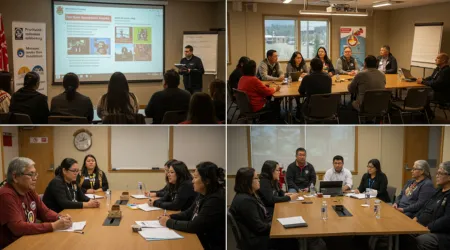New Provincial Initiatives to Support Indigenous Education and Reconciliation

Provincial Initiatives in Canada are redefining Indigenous education, anchoring reconciliation in classrooms and communities.
The scars of residential schools and systemic inequities linger, demanding more than apologies—authentic, transformative action.
Education, a vessel for culture and identity, is where provinces are channeling efforts to honor Indigenous voices, close opportunity gaps, and rebuild trust.
From British Columbia’s curriculum reforms to Manitoba’s culturally safe schools, these policies reflect a nation grappling with its past while envisioning an equitable future.
Yet, progress is uneven, and the stakes are monumental. How do we ensure these initiatives deliver meaningful change?
This exploration dives into Canada’s 2025 efforts, blending hope, critique, and a call for accountability, grounded in real-world examples and data.
Reconciliation through education isn’t a buzzword; it’s a moral and practical necessity.
Provincial initiatives aim to dismantle colonial frameworks, integrate Indigenous knowledge, and empower communities.
These efforts respond to the Truth and Reconciliation Commission’s (TRC) 2015 Calls to Action, particularly numbers 62 and 63, which urge culturally relevant education and teacher training.
But progress requires scrutiny. Are these policies bold enough to address entrenched disparities?
With Indigenous students facing a 48% high school graduation rate compared to 84% for non-Indigenous peers (Statistics Canada, 2021), the urgency is clear.
Like a river carving new paths, education can either nourish or erode—provinces must ensure it fosters equity, not optics.
British Columbia: Co-Creating Culturally Rich Curricula
British Columbia’s provincial initiatives shine through the 2025 Indigenous Education Enhancement Agreement (IEEA).
This policy mandates school districts collaborate with local First Nations to co-develop curricula, embedding Indigenous perspectives.
In Haida Gwaii, the school district partnered with the Haida Nation to integrate Haida language and storytelling.
Students now explore Haida governance alongside math, fostering cultural pride. This localized model shows how education can reflect community identity, but scaling it province-wide faces logistical hurdles.
Another layer of B.C.’s approach is professional development. The 2025 Indigenous Knowledge Integration Program trains teachers to deliver culturally responsive lessons.
A teacher in Prince George shared, “I learned to weave Kwakwaka’wakw art into geometry, making math resonate.”
Yet, rural schools struggle with access to trainers, highlighting uneven implementation. Without consistent support, urban-rural divides could widen.
B.C. also invests in student support. The 2025 First Nations Student Success Fund allocates $20 million for mentorship and tutoring in Indigenous communities.
In Kamloops, Secwépemc elders mentor youth, blending academic guidance with cultural teachings. This initiative boosts retention, but funding must be sustained to avoid short-term gains.
+ Canadian Consumer Confidence Hits a New Low Amid Trade Uncertainty
Ontario: Empowering Educators, Engaging Students

Ontario’s provincial initiatives prioritize teacher training to bridge cultural gaps.
The 2025 Indigenous Cultural Competency Program requires educators to complete 40 hours of training on Indigenous histories and pedagogies.
A Toronto teacher reflected, “I shifted from teaching ‘Canadian history’ to Turtle Island’s story.”
This reframing is powerful, yet critics note the absence of mandatory Indigenous language courses for students limits impact.
Beyond training, Ontario funds Indigenous-led programs. The 2025 Anishinaabe Youth Leadership Initiative supports after-school cultural workshops in Thunder Bay.
Students learn Ojibwe beadwork while discussing identity, building confidence. However, urban-focused funding leaves rural communities underserved, a gap provinces must address.
Ontario’s curriculum updates also stand out. By 2025, every grade includes Indigenous history and perspectives, from treaties to contemporary issues.
In Ottawa, Grade 7 students study Métis contributions to Confederation, sparking curiosity. Yet, teachers report insufficient resources, like updated textbooks, which risks diluting these efforts.
Also read: The Role of Digital Literacy in Shaping Tomorrow’s Workforce
Manitoba: Building Spaces for Healing and Learning
Manitoba’s provincial initiatives focus on infrastructure to create culturally safe learning environments.
A $50 million 2025 investment funds schools in First Nations communities, designed with Indigenous architects.
In Peguis First Nation, a new school features a circular classroom modeled on medicine wheels, symbolizing holistic learning.
Delays in federal-provincial funding coordination, however, slow construction.
Manitoba also emphasizes elder involvement. The 2025 Elders-in-Schools Program embeds Indigenous knowledge keepers in classrooms.
In Thompson, Cree elders teach traditional land-based skills, enriching science lessons. Teachers note higher student engagement, but elder availability varies, especially in remote areas.
Another effort targets early education. Manitoba’s 2025 Indigenous Head Start Expansion funds preschool programs blending Cree and Ojibwe languages with literacy.
In Winnipeg, children learn counting through traditional stories, fostering pride. Yet, program reach is limited, underscoring the need for broader investment.
Yukon: Community-Driven Education Models
Yukon’s provincial initiatives empower communities to lead. The 2025 Yukon First Nation Education Conference, hosted by the Yukon First Nation Education Directorate, gathered 300 educators to explore Indigenous-led curricula.
Workshops on beading climate data blended science with culture, inspiring innovation. Attendee Tanis Van Bibber noted, “Jordan’s Principle funding is shaky—we need stability.”
Yukon also supports language revitalization. The 2025 Southern Tutchone Language Program trains teachers to deliver bilingual lessons.
In Whitehorse, students learn Tutchone greetings alongside spelling, preserving heritage. Limited fluent speakers, however, challenge expansion, requiring creative solutions like digital tools.
Another strength is land-based learning. Yukon’s 2025 Indigenous Outdoor Education Fund supports camps teaching traditional skills.
In Carcross, Tagish youth learn fish-trapping, connecting ecology and culture. These programs boost engagement, but scaling them demands more trained facilitators.
Saskatchewan: Navigating Implementation Challenges
Saskatchewan’s provincial initiatives aim high with the 2025 Truth and Reconciliation Education Framework, mandating Indigenous history in every grade.
In Regina, Grade 10 students study Treaty 4’s impacts, fostering critical thinking. Teachers, however, report feeling unprepared due to limited training, a gap that undermines progress.
Saskatchewan also funds community partnerships. The 2025 Indigenous Education Alliance connects schools with First Nations to develop resources.
In La Ronge, Cree elders co-created a history unit, enriching lessons. Rural schools, however, lack reliable internet for collaboration, highlighting infrastructure needs.
Another initiative targets student support. The 2025 Indigenous Mentorship Program pairs at-risk youth with cultural mentors.
In Saskatoon, a student credited her mentor with inspiring graduation. Yet, program funding is precarious, risking disruption without long-term commitments.
Measuring Impact: Challenges and Opportunities
| Province | Initiative | Key Feature | Challenge |
|---|---|---|---|
| British Columbia | Indigenous Education Enhancement Agreement | Co-developed curricula with First Nations | Scaling to all districts |
| Ontario | Indigenous Cultural Competency Program | Mandatory teacher training | Limited student language programs |
| Manitoba | Culturally Safe School Infrastructure | Indigenous-designed schools | Funding delays |
| Yukon | Yukon First Nation Education Conference | Community-driven curricula | Unstable funding |
| Saskatchewan | Truth and Reconciliation Education Framework | Indigenous history in all grades | Teacher preparedness |
These provincial initiatives are steps toward equity, but challenges persist. The 48% Indigenous graduation rate (Statistics Canada, 2021) reflects systemic barriers—poverty, underfunded reserves, and cultural disconnect.
Education is like a river: it can nourish or erode, depending on its course. Provinces must align funding, training, and community input to ensure impact.
Accountability is key. Regular evaluations, like B.C.’s IEEA progress reports, track outcomes but need transparency.
Involving Indigenous communities in oversight, as Yukon does, ensures policies stay grounded. Without this, initiatives risk becoming symbolic gestures rather than transformative tools.
Provinces must also share best practices. Manitoba’s elder program could inspire Ontario, while B.C.’s curriculum model could guide Saskatchewan.
Collaboration, paired with sustained federal support, can amplify impact, turning isolated successes into a national movement.
Conclusion: A Journey Toward Justice
Canada’s provincial initiatives in 2025 are planting seeds for reconciliation, but seeds need care to grow.
From Haida Gwaii’s classrooms to Peguis’s medicine wheel-inspired schools, these efforts weave Indigenous knowledge into education’s fabric.
Yet, uneven funding, training gaps, and systemic inequities threaten progress. Why do Indigenous students still face stark disparities? Answering this demands heart, humility, and relentless commitment.
These initiatives are more than policies—they’re a promise to heal and rebuild. By centering Indigenous voices, investing wisely, and confronting colonial legacies, provinces can redefine education.
Let’s celebrate successes, like Yukon’s land-based camps, while holding governments accountable.
Reconciliation isn’t a finish line; it’s a journey requiring every Canadian to walk together, ensuring education becomes a beacon of justice and hope.
Frequently Asked Questions
What are provincial initiatives for Indigenous education?
They’re policies integrating Indigenous knowledge, training educators, and building culturally safe schools to support reconciliation and equity.
How do these initiatives address reconciliation?
They respond to TRC Calls to Action by embedding Indigenous histories, languages, and perspectives, fostering cultural pride and healing.
What challenges do provinces face?
Funding delays, uneven training, and systemic barriers like poverty and underfunded reserves hinder consistent implementation.
How can communities get involved?
Communities can partner with schools, as in B.C.’s IEEA, or advocate for stable funding and culturally relevant curricula.
